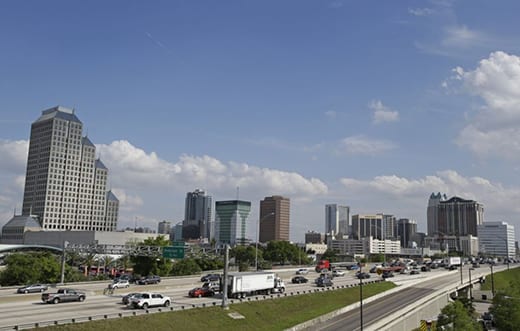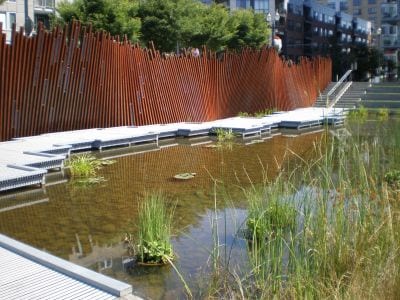JOHN NOLEN’S ADVICE OFFERED TO ORLANDO PLANNERS

Planners Could Use Highway Makeover to Design a More Humane Orlando
Op-ed, Next City
January 19, 2016
The Florida Department of Transportation (FDOT) is overseeing “I-4 Ultimate,” a $2.1 billion “makeover” of a 21-mile stretch of a busy freeway that runs through downtown Orlando. The agency claims adding lanes and re-engineering interchanges will improve the economy while “enhancing livability for everyone.” Given that Florida has the nation’s highest bicyclist death rate and that metropolitan Orlando (followed by Tampa Bay, Miami and Jacksonville) suffers the nation’s highest pedestrian death rate, FDOT’s definition of “livability” is open to conjecture.
Till now, I-4 has been an impediment to livability, but, with FDOT elevating the interstate, planners in Orlando (where I lived until last June) hope to reclaim a desolate section of underpass (owned by FDOT) in the downtown. They envision a“Bridge District,” a linear five-block park bounded by Amway Arena and Creative Village, a planned 34-acre transit-oriented development.
The Bridge District vision is ambitious. Proposed uses include soccer fields, basketball courts, tennis courts, playgrounds, a splash park, a bocce court, a dog walk, a civic plaza, an immense sand box and a retail district. Officials recognize the proposal is highly conceptual. There is scant precedent for humans enjoying recreation under noisy, traffic-laden interstates, and some cities are instead opting to remove downtown freeways and replace them with surface-level boulevards. No one knows if the Bridge District will become a destination, but it could enhance livability. The key is to create an environment designed for human movement and what Frederick Law Olmsted, the father of American landscape architecture, called “re-creation,” the clearing of the mind from the psychic strain of urban life.
Olmsted provided ample examples through his designs. Pedestrians, bicyclists and traffic move through New York’s Central Park without impeding the sublimity of its pastoral setting. In Boston, the Emerald Necklace allows citizens to transverse the city without a car on the edge of nature. Prospect Park, however, is the exemplar for “re-creating” pedestrians. When you enter the park off Flatbush Avenue, Brooklyn’s clamor quickly recedes after a short walk to the Endale Arch, the entrance to a 100-foot-long tunnel that is not unlike an underpass. Emerging from the dark tunnel, one is engulfed by light just as the iconic Long Meadow comes into view. “The light seems to be converging on the meadow from all directions,” Tony Hiss writes, “tumbling on the grass nearby and glowing through the trees beyond the meadow.” This transcendental experience celebrates Olmsted’s genius for enlivening the senses. Hiss, in his masterful book The Experience of Place, describes how good design provides transitions that heighten awareness as one moves through an urban park. This is the test the Bridge District must pass, but it will be difficult in a park devoid of nature.
Experiencing nature is essential to re-creation. Capturing a small percentage of the stormwater that pours off I-4 into pipes and nondescript retention ponds could create a centerpiece for the Bridge District. Tanner Springs Park, a square block of restored natural habit on a former rail yard in Portland, Oregon’s Pearl District (where I live now), has a recreated wetland that filters stormwater. Water flows through runnels designed to tune the trickle of water into a natural harmony, an attempt to engage the senses the city deadens. If the Bridge District is to offer an antidote to I-4’s mechanical drone, water must flow and nature must thrive

The Bridge District should also be a work of art. At Tanner Springs, a 12-foot-high wall of 368 undulating recycled rail ties borders one edge of the park. Chunks of cobalt blue glass with hand-painted abstractions of lost wildlife were fused into the rails.
The eastern block of the Bridge District is already slated to employ art: Murals will depict the rich community life of Parramore, the historic African-American neighborhood that I-4 marginalized. (The neighborhood was further fragmented in 1973 when construction of the East-West Expressway claimed homes and businesses.)
Integrating Parramore into the downtown could reverse decades of discrimination. Racism has blighted city planning in Florida since John Nolen prepared the state’s first comprehensive plan in 1923. Hired to design an American Riviera, the Olmsted disciple’s plan to create a world-class tourist destination included raising living standards in the underserved African-American community. The plan met stiff opposition and received just 13 percent of the vote in a whites-only referendum.
Now, the University of Central Florida plans to establish a downtown campus in Creative Village, adjacent to Parramore. (In 2013, a $2.4 millionHUD Sustainable Communities Regional Grant funded a plan to rejuvenate the neighborhood.) The energy and expertise of the nation’s second-largest university will activate the area; Parramore could become an epicenter of “cradle to career” opportunities in an unprecedented partnership among government, higher education, Orange County School Board, civic organizations, private enterprise and the community.
Orlando is primed to recast its history. If Nolen failed to diminish racial injustice, his vision of an efficient, humane city lives on. Today his blueprint for the pedestrian-oriented, mixed-use neighborhood informs a new generation of practitioner, and the plans for Creative Village and Parramore bear his imprint. At the same time, building a human-scaled downtown in a region that suffers a traffic death every 44 hours demands a clear conception of livability. Florida desperately needs the prototype downtown Orlando’s planners have envisioned. An urban renaissance is brewing — it just needs citizens to invest in their humanity as well as their machines. Striking this balance is the essence of planning, as conceived by Olmsted and Nolen. “We shall not use our power over machinery to produce more and more elaborate machinery,” Nolen declared. “We shall use our new powers to secure leisure and to enjoy life itself and its arts.”
By: Bruce Stephenson
Bruce Stephenson is the author of John Nolen, Landscape Architect and City Planner. He is living in Portland, Oregon, while on sabbatical from Rollins College, and working on a new book, Stepping Into Sustainability: Living New Urbanism in Portland and Orlando.